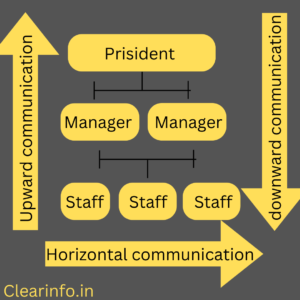In this blog, we will focus on the merits and demerits of formal communication with real examples and templates. The blog also talk’s about the characteristics of formal communication, in addition to the difference between formal and informal communication.
Advantages of Formal Communication:
Formal communication is a critical part of business communication. In this section, we will look at points that emphasize the importance of formal communication in a business.
The advantages of formal communication are as follows:
1) Systematic communication: Formal communication relies on following the organization’s structure and chain of command to convey information. This helps in a seamless flow of information from one level to another. The levels of communication are:

-
- Upward Communication: Information flows from subordinates to superiors.
- Downward Communication: Information flows from superiors to subordinates.
- Horizontal Communication: Information flow between members on the same level in an organization.
- Crosswise Communication: Information flow between different levels of an organization with no direct reporting relationship. Also known as diagonal communication.
2) Better coordination and control: Another benefit of having formal communication channels in a company is that it ensures effective control over business operations. Information is relayed using the guidelines set by the organization. The roles of various company members are clearly defined and the chain of information flow is set to avoid any confusion.
3) Helps in maintaining permanent records: There are two main types of communication channels used in communication – verbal communication and written communication. Written communication forms such as letters, reports, memos, etc. are all filed and kept permanently as records. Verbal forms of communication can be recorded as well in the form of voice memos.
Realted Reading:
4) Better discipline among employees: Formal business communication boosts discipline in a company as it eliminates conveying of unnecessary information. Reports are overlooked by managers to ensure only relevant data is passed between different levels of the organizational structure.
5) Emphasis on work: One of the prime merits of formal communication is that all employees in a company have predefined roles and tasks allotted to them. A formal communication system in an organization promotes focusing more on work and less on interpersonal relationships during business hours.
6) Stability to the company: A key objective of formal communication is to help a company in maintaining a stable position. It eliminates chaos as the chain of command is clearly defined. All activities are documented and reported to the concerned authority. This gives the company a solid organizational structure.
Extra Insight:
Advantages of formal communication in an organization
Formal communication is an essential component of any organization. One of the main advantages of formal communication in an organization is that it ensures clarity and accuracy of information.
In a formal communication setting, the message is well-defined and structured, which reduces the likelihood of misunderstandings or confusion. Secondly, formal communication provides a record of communication that can be referred to in the future. This is important, especially in legal or contractual matters.
Disadvantages of Formal Communication
Now we will look at some of the limitations of formal communication. They are:
1. Rigid communicative process: The roles of employees in a company are predefined. They must only do what they are asked and follow strict guidelines. This eliminates the scope for creative thinking and unconventional approaches which could not benefit the business.
2. Ignores human relationships: A formal communication model only focuses on work and information related to work. Which means only formal and impersonal language is used. This demerit of formal communication ignores the human element in business.
3. Causes delays in decision-making: The flow of information in a formal structure has to follow an established framework. This can cause a wastage of time and cause delays in decision-making as information must pass through various levels of an organization.
4. Formal communication is costly: This type of business communication relies on formal means of conveying information. This can be costly for a business as setting up channels of formal communication between different levels of a company is expensive.
This is the biggest limitation of formal communication as it includes expenses such as – paper and stationery supplies, providing employees with mobile phones and computers, etc.
5. Inapplicable in emergency situations: Another reason why you should not use formal communication is in case of any accidents and mishappenings, formal communication is unnecessary as it is time-consuming. This prohibits the free flow of information. During a crisis, it is critical that information should be conveyed quickly and concisely.
Extra Insight:
Limitation of formal communication in an organization
While formal communication is an important component of any organization, it does have its limitations Firstly, formal communication can be time-consuming and may require a lot of effort to prepare. This can be a disadvantage, especially in situations where quick decisions need to be made.
Secondly, formal communication can be one-way and may not allow for feedback or discussion. As a result, subordinates may face challenges in asking questions, potentially resulting in misunderstandings or misinterpretations.
In summary
Formal communication has several advantages including systematic communication, better coordination and control, maintaining permanent records, and stability to the company.
However, it also has limitations such as rigid communicative processes, ignoring human relationships, causing delays in decision-making, being costly, and being inapplicable in emergency situations.
The following list of pros and cons of formal communication can help an organization decide whether opting for a formal communication mode can be an effective method of communication for the organization or not.
Formal communication Examples
Example 1.0 represents a Formal Introduction of Dr. Edward Smith. given by MARGARET to MR. WILSON.
Example 1.0
MARGARET: Mr. Wilson, I’d like you to meet Dr. Edward Smith.
MR. WILSON: It’s nice to meet you, Dr. Smith.
DR. SMITH: Pleasure to meet you, too.
MARGARET: Dr. Smith is an economist. He just finished writing a book on international trade.
MR. WILSON: Oh? That’s my field, too. I work for the United Nations.
DR. SMITH: In the Development Program, by any chance?
MR. WILSON: Yes. How did you guess?
DR. SMITH: I’ve read your articles on technical assistance. They’re excellent.
Example 2.0 represent Formal Greetings between professor Austin and his two students James and Emma.
Example 2.0
JAMES: Good morning, Professor Austin, how are you doing?
PROFESSOR AUSTIN: Good morning, James. I am doing well. And you?
JAMES: I’m great, thank you. This is my friend Emma. She is thinking about applying to this college. She has a few questions. Would you mind telling us about the process, please?
PROFESSOR AUSTIN: Hello, Emma! It’s a pleasure to meet you. I’m more than happy to speak with you. Please stop by my office next week.
EMMA: It’s a pleasure to meet you, professor. Thank you so much for helping us.
PROFESSOR AUSTIN: Don’t mention it. Hopefully, I will be able to answer your questions!
Below is the live conversation template for formal communication that you can use while calling.
Formal conversation:
Good morning, this is ………… May I speak to ………… please?
Good morning, hold on, please. I’ll put you through.
Thank you.
You’re welcome. I’m terribly sorry …….. is not available at the moment. Would you like to leave a message?
Yes, please. Could you tell him/her that ………… called?
Yes, of course.
Thank you very much, good day!
Goodbye!
Do’s and don’ts of formal communication
Do’s:
- Follow the established structure and chain of command in your organization while communicating.
- Use a formal and professional tone in your written and verbal communication.
- Ensure that your written communication adheres to proper grammar, spelling, and punctuation.
- Clearly define the purpose of your communication and provide all necessary details.
- Maintain confidentiality and privacy of sensitive information.
- Address the recipient with the appropriate salutation and title.
- Make sure to keep your communication brief and straightforward.
Don’ts:
- Use informal language, jargon, or slang in your communication.
- Include all caps or excessive exclamation marks in your written communication.
- Assume that the recipient already knows what you are talking about which can lead to misunderstandings.
- Share sensitive or confidential information with unauthorized individuals.
- Use offensive or inappropriate language or behavior in any communication.
- Employ complex language or technical jargon that the recipient may not understand.
- Delay or ignore responding to formal communication, especially if it requires a timely response.
Characteristics of Formal Communication:
- Rules and norms: Strict guidelines and regulations are to be followed using formal communication channels.
- Routine activity: Formal communication is used by different levels of an organization to handle day-to-day activities.
- Work-focused: Formal communication only focuses on objectives, business activities, and work done by employees.
- Chain of command: In a formal communication structure, the sender and receiver of information are officially pre-decided.
- May be oral or written: It is a communication type that can be written or oral (telephonic, electronic, etc.
Related reading: Advantages and disadvantages of oral communication
Advantages and Disadvantages of Informal Communication
Informal communication is also referred to as grapevine communication. It takes the form of casual communication between employees which does not follow a chain of command.
In this section, we will look at the advantages and disadvantages of informal communication.
Advantages of informal communication:
1. Fast transmission: Informal communication includes speech and listening, making it prompt and quick in transmission.
2. Better cooperation and coordination: It helps in building team spirit between employees in a company.
3. Better human relations: Informal communication helps in improving human relationships and employee morale.
4. Instant feedback: The receiver of a message can offer the sender feedback immediately.
5. Close contact: It facilitates direct contact between the receiver and sender of information.
Disadvantages of Informal Communication:
1. No documentation: Informal communication is not documented and kept as permanent records.
2. Possibility of denial: Both sender and receiver can deny information conveyed during verbal communication.
3. No lasting effect: Information can be forgotten, distorted, or misconstrued.
4. Not apt for long-term communication: It is more suitable to communicate messages with long-term significance in a formal format.
5. Creation of gossip: Informal communication can create gossip and confusion.
Read our in-depth blog on advantages and disadvantages of informal communication.
Difference between Formal and Informal Communication
- Form: Formal communication follows the chain of command of a structured organization whereas informal communication does not.
- Function: Formal communication is used to transmit official messages in a structured and prescribed format. Informal communication involves casual and personal conversation.
- Nature: Formal communication is routine and rigid in nature, whereas informal communication is dynamic, spontaneous, and flexible in nature.
- Focus: While formal communication solely focuses on work and business-related information, informal communication helps in building interpersonal relationships among employees.
- Movement: Formal communication moves in downward, upward, horizontal and crosswise directions. Informal communication is a grapevine type of communication.
Further Reading: What is the difference between informal and formal communication
Extra Insight:
What are the advantages and disadvantages of formal and informal communication?
One of the advantages of formal communication is that it is structured and organized, which makes it easier to understand and follow. However, a disadvantage of formal communication is that it can be rigid and may lack the personal touch that informal communication provides.
Conversely, informal communication is characterized by a more relaxed and casual tone.. It is often used in social situations, and it allows people to express themselves freely without the restrictions of formal communication. However, a disadvantage of informal communication is that it may not always be appropriate in certain situations, such as in a professional setting.
Why formal communication is structure communication?
Formal communication is structured communication because it follows a predetermined structure and hierarchy within an organization. In formal communication, information flows through established channels and follows a chain of command, which ensures that the right information is conveyed to the right people at the right time. This structure ensures that communication is consistent, efficient, and effective, and reduces the risk of miscommunication or misunderstandings.
What type of communication is not suitable for a formal organization?
The type of communication that is not suitable for a formal organization includes informal communication (such as gossiping or spreading rumors), personal communication (such as discussing personal issues), and aggressive communication (such as yelling or using abusive language). Communication in a formal organization should be professional, structured, relevant, and respectful to ensure that the organization functions efficiently and effectively.
Frequently Asked Questions
Q1. What is not an advantage of formal communication?
Ans- Delays caused in decision making is not an advantage of formal communication. Information is required to pass through a prescribed line of command and formalities must be met before it is conveyed. This process is time-consuming and can cause delays in decision-making.
Q2. What is the purpose of formal communication?
Ans- Formal communication is used to communicate information using a prescribed structure following the line of command in an organization. This information is well documented and can be used for future reference.
Q3. What is formal communication?
Ans- Formal communication is a type of business communication. It relies on following organizational structures and following strict guidelines. This is used to convey official information between different levels of a company.
Q4. Is formal communication expensive?
Ans- Formal communication is costly as a large amount of money is spent on stationary. Along with this, manpower is employed to deliver reports and letters to the concerned recipients.



